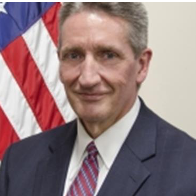Leadership Interview
 Joe Carter
Joe Carter
Steering Committee Chair
Mr. Carter is the Systems Engineering Lead at the U.S. Army PEO Aviation and the Chair the FACE™ Steering Committee. We sat down with him to find out what challenges he sees confronting the FACE Consortium and what we need to do to prepare for them.
Joe, thank you for taking the time to be interviewed for the first FACE Newsletter. You have always been open, accessible, and willing to share, so we are looking forward to this discussion. To start, how long you have been involved in the FACE Consortium and what are you current responsibilities with the Army?
Joe: I have been involved in the FACE Consortium for seven years, and I just began my fourth year as the Steering Committee Chair. At PEO Aviation, I am the Systems Engineer Lead and lead the tactical branch in G10. Some of my responsibilities include leading the digital engineering environment, integrating MBSE through-out the PEO, assisting the tactical systems to achieve Army Interoperability Certification and supporting the PEO MOSA Transformation Office in architecture and standards. I also chair the Army’s Real Time, Safety Critical, Embedded Computing Environment Working Group that is part of the Army’s COE.
Please tell us about one of the several positive impacts you have had on the FACE Consortium.
Joe: Before I was elected chair three years ago, I noticed that several key leaders were wearing too many leadership hats, so they were being spread too thin and struggled to dedicate the time to all of their responsibilities. This caused unnecessary delays in releasing certain documents and decisions. Therefore, one of the changes I started making was spreading out leadership responsibilities by encouraging only one leadership role per individual. I believe this has helped develop more leaders, keeps people more engaged, and lessens the impact when we experience turnover.
It has been 11 years since the FACE initiative was first launched. What were the original goals of the FACE Consortium and what are they today?
Joe: The key goals of improving the affordability of capabilities and delivering capabilities to the warfighter faster have not changed. These goals drove the establishment of the FACE Consortium back in June 2010 and they still drive us today. I believe having these stable goals really helps ground the FACE Consortium and keeps us on track.
Is the FACE Approach ready for more widespread use?
Joe: Yes. The FACE Approach includes business processes, technical practices, and an open component-based software standard. Even though we are focused on the aviation software domain, good software engineering is good software engineering regardless of the domain. The recent MOSA guidance and policies from congress, DoD, and the services have influenced our business processes, recommendations, and outreach, but we already had a solid foundation to build upon. We have already seen other industries like the oil refinery industry leverage the good work we have done. There continues to be international interest, and we have made significant progress towards allowing international participation in the FACE Consortium.
How has the recent MOSA guidance impacted the FACE Consortium?
Joe: I am glad you asked that question. The founders of the FACE Consortium deserve credit for establishing a strong foundation and incorporating the MOSA principles.
So to answer your question about how MOSA guidance has impacted the FACE Consortium, our most significant efforts are in outreach to let everyone know that the FACE Approach addresses all 5 Principles of MOSA. This really separates us from other open standards, because they do not have an independent and operational conformance program and most do not have an established enabling environment as extensive as ours that covers business resources, tools, training, examples, and certified conformant capabilities.
Putting on my Army PEO Aviation hat, our organization is embracing MOSA and, to be honest, being disruptive to current contracting and engineering activities that do not support a modular open systems approach. Moving forward, we plan to make MOSA a source selection discriminator in future solicitations.
